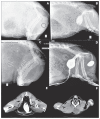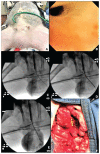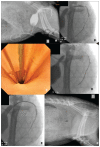Management of obstructive urethroliths, urethral pseudodiverticulum, and stricture by diverticulectomy, urethroplasty, and urethral stenting placement in a male goat
- PMID: 37529384
- PMCID: PMC10352047
Management of obstructive urethroliths, urethral pseudodiverticulum, and stricture by diverticulectomy, urethroplasty, and urethral stenting placement in a male goat
Abstract
A 5-year-old wether was presented for an acute onset of loss of appetite and inability to urinate. Urethral urolithiasis causing urethral obstruction was diagnosed and a cystostomy catheter was placed. The wether continued to be unable to urinate through the urethra and further developed a perineal pseudodiverticulum. Diverticulectomy followed by a urethroplasty using porcine small intestinal submucosa was performed to relieve the obstruction. The wether developed a urethral stricture following urethroplasty and the owners refused a perineal urethroplasty. Cystourethrography, fluoroscopic-guided balloon dilations, and urethral stent placement were done to establish urethral patency. The wether developed tissue ingrowth through the stent, resulting in recurrent obstruction that necessitated placement of covered urethral stents. Key clinical message: Although obstructive uroliths usually carry a guarded prognosis in small ruminants, the use of novel interventional radiology techniques along with urethroplasty using a xenograft allowed a wether to achieve urethral patency and normal urinations.
Prise en charge d’un bouc présentant des urétrolithes osbtructifs, un pseudodiverticule urétral et une stricture par diverticulectomie, urétroplastie et placement d’un stent urétral. Un bouc castré de 5 ans a été présenté pour une perte aigüe d’appétit et une incapacité à uriner. Un calcul urétral provoquant une obstruction urinaire a été diagnostiquée et une sonde de cystotomie placée. Le bouc a continué d’être incapable d’uriner pas son urètre et a développé un pseudodiverticule périnéal. Une diverticulectomie suivie d’une urétroplastie utilisant de la sous-muqueuse d’intestin grêle de porc a été réalisée pour soulager l’obstruction. Le bouc a développé une stricture urétrale à la suite de l’urétroplastie et les propriétaires ont refusé une urétroplastie périnéale. Une cystourétrographie, des dilatations par ballonnets guidées par fluoroscopie ainsi que le placement d’un stent urétral ont été réalisés afin de résoudre l’obstruction urétrale. Le bouc a développé une réaction tissulaire envahissant la lumière du stent, entrainant ainsi une nouvelle obstruction et nécessitant la mise en place de stents urétraux couverts.Message clinique clé :Bien que les urolithes obstructifs aient généralement un pronostic réservé chez les petits ruminants, l’utilisation de nouvelles procédures provenant de la médecine interventionnelle associées à une urétroplastie utilisant une xénogreffe a permis d’obtenir une perméabilité de son urètre et des mictions normales chez ce bouc.(Traduit par les auteurs).
Copyright and/or publishing rights held by the Canadian Veterinary Medical Association.
Figures





References
-
- Leib M, Dinnel H, Ward D, et al. Endoscopic balloon dilation of benign esophageal strictures in dogs and cats. J Vet Intern Med. 2001;15:547–552. - PubMed
-
- Smith MC, Sherman DM. Goat Medicine. 2nd ed. Ames, Iowa: Wiley-Blackwell; 2009. Urinary system; pp. 537–569.
-
- Janke JJ, Osterstock JB, Washburn KE, et al. Use of Walpole’s solution for treatment of goats with urolithiasis: 25 cases (2001–2006) J Am Vet Med Assoc. 2009;234:249–252. - PubMed
Publication types
MeSH terms
LinkOut - more resources
Full Text Sources
